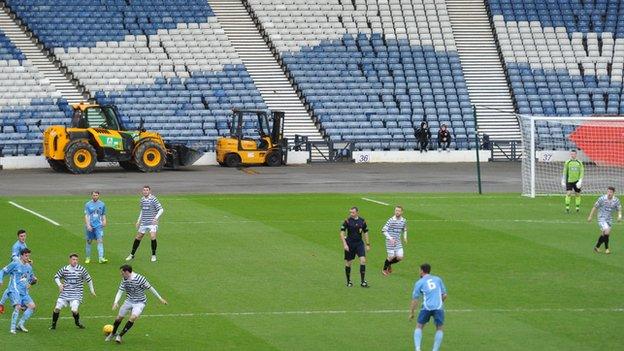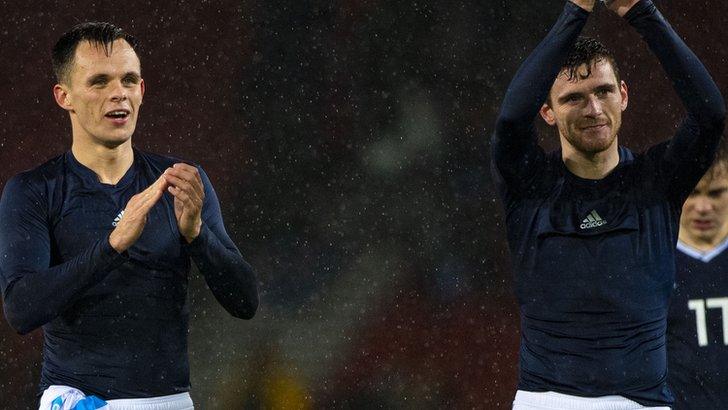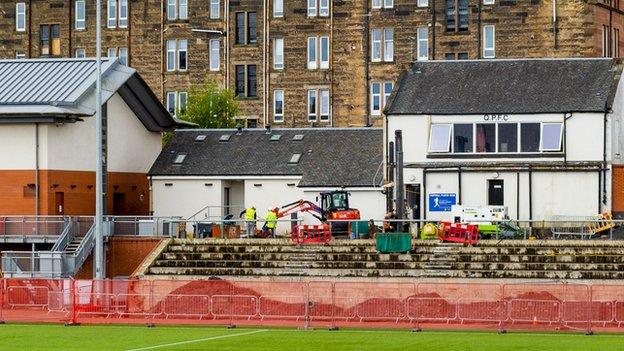Queen's Park: President Gerry Crawley on the club's ambitious new era
- Published

The 2020-21 campaign will be Queen's Park's last playing at the national stadium
"The change in the club is huge. We didn't turn professional to stay in League Two."
Having shed their 152-year status as an amateur club, upwardly mobile Queen's Park are in a hurry to make their mark.
A signing spree that is the envy of the lower leagues is a show of intent as Scotland's oldest club bid to forge an exciting new history.
As Queen's begin their final season playing at Hampden Park, club president and former player Gerry Crawley discusses an ambitious step into the unknown.
'We were never going to be happy with selling Hampden'
Wiping out your debt in one swoop with a £5m sale sounds a nifty piece of business. It certainly makes financial sense, but the emotional wrench of leaving Queen's Park's "ancestral home" for the last 117 years still lingers for Crawley.
The Scottish FA initiated talks over buying the national stadium two years ago, with a deal completed in June 2019 and the governing body taking ownership in August this year.
The cash allowed the League Two club to free themselves from financial debt, but it's hard to put a price on how much the place meant to everyone connected with Queen's.
"We were never seeking to sell Hampden. We were leveraged really," says Crawley.
"However, we got to a point as a club where we valued the stadium and considered the repercussions of not selling it. Then it was about finding the right price we were satisfied with. We were never going to be happy with it.
"I was trying not to be emotional about it and thinking about what happens if it goes wrong, but you just have to try and find the best outcome in those circumstances."
'What happened to Berwick and East Stirling won't happen to us'
If their reluctant stadium sale represents Queen's moving with the times, so does their switch to professional status.
Having been in the bottom two tiers since league reorganisation in 1994-95, they are well aware of the increasingly shifting sands below.
The SPFL's pyramid system now poses the daunting prospect of relegation from Scotland's fourth tier - with well-backed rivals lurking in the Lowland and Highland divisions. The two clubs that have dropped out of the SPFL have yet to return.
"I wouldn't say it became a no-brainer [to turn professional], but we just had to," says Crawley.
"It meant we could avoid looking over our shoulders. We've watched what happened to Berwick and East Stirling and we've changed the course of our history to make sure that doesn't happen to us."

Queen's Park's amateur status meant both Lawrence Shankland (left) and Andy Robertson (right) were able to leave without the club receiving compensation
Queen's voted to end their historic amateur status last November, becoming the last senior side in Scotland to turn professional.
Previously the Glasgow club only paid expenses to players, but as of January this year all their squad were offered part-time contracts.
Having produced the likes of Scotland stars Andy Robertson and Lawrence Shankland from their youth system, only to lose them for not a penny in compensation, they are now in a position to profit from rearing their own.
"We have a thriving youth system that we're proud of," adds Crawley. "But we were developing players and we weren't being compensated.
"We're fully committed to running it and now we can possibly improve it. We want to introduce a stream of west of Scotland talent to play in our first team."
'We're on the cusp of something exciting'
With a redevelopment of Lesser Hampden set to be complete by spring next year, with an initial capacity of around 1,700, Queen's have ambitions to increase their fanbase in their new home.
Despite being the lesser of Glasgow's professional clubs, Crawley believes there is a gap in the market they can exploit.
"Glasgow is a football-mad city," says Crawley. "There's Rangers and Celtic, and there's Partick Thistle north of the river. We think there's a gap for a club like us and we want to take advantage of that.
"We're trying to modernise the club. What we hope we can do is build an atmosphere and a crowd to certainly get to 1,000 supporters then aim for capacity."
Before the move to Lesser Hampden next season, Crawley insists fans have reason to be excited in the meantime.
The bottom-tier club's transfer business has raised eyebrows, with manager Ray McKinnon's recruitment drive including former Premiership talents Cammy Bell, Simon Murray and Bob McHugh.
Crawley is confident this will provide the platform to meet the expectations of the club's "three to four-year plan", with the second tier in his sights.
"The change in the club is huge because there was an impossibility of considering how we could get to the Championship in a way that smaller clubs like Arbroath and Alloa have done.
"We are putting a very talented group of players together and we think we are on the cusp of something very exciting."

Construction work, set to be complete by spring next year, is currently ongoing at Lesser Hampden